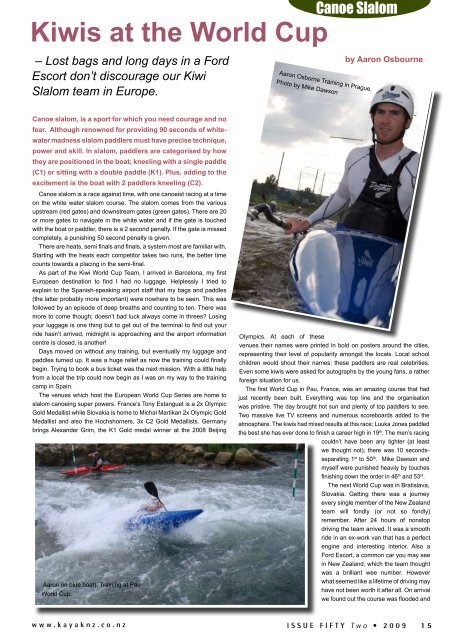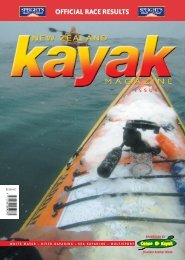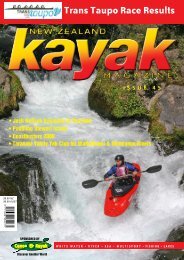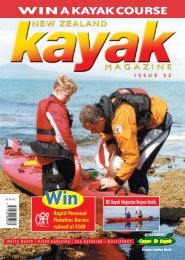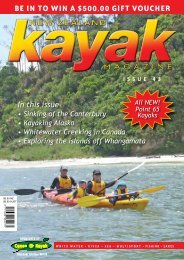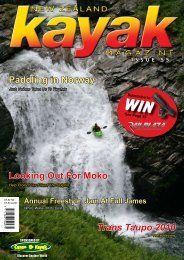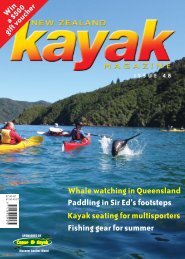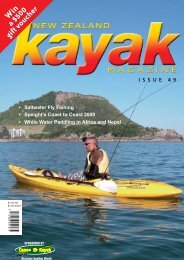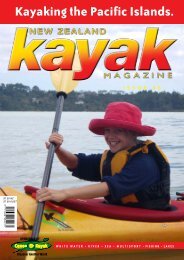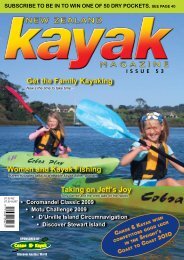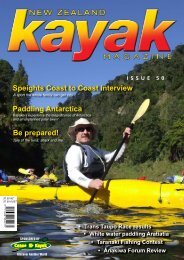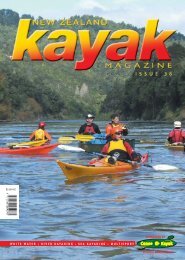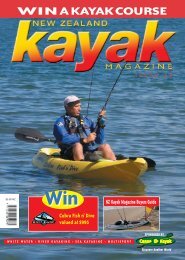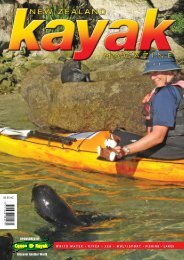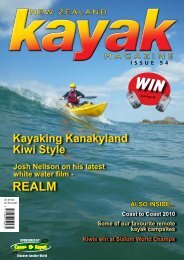Wasps, Wakas & Wallabies Nepal Update Getting ... - Canoe & Kayak
Wasps, Wakas & Wallabies Nepal Update Getting ... - Canoe & Kayak
Wasps, Wakas & Wallabies Nepal Update Getting ... - Canoe & Kayak
Create successful ePaper yourself
Turn your PDF publications into a flip-book with our unique Google optimized e-Paper software.
Kiwis at the World Cup<br />
– Lost bags and long days in a Ford<br />
Escort don’t discourage our Kiwi<br />
Slalom team in Europe.<br />
<strong>Canoe</strong> Slalom<br />
Aaron Osborne Training in Prague.<br />
Photo by Mike Dawson<br />
by Aaron Osbourne<br />
<strong>Canoe</strong> slalom, is a sport for which you need courage and no<br />
fear. Although renowned for providing 90 seconds of whitewater<br />
madness slalom paddlers must have precise technique,<br />
power and skill. In slalom, paddlers are categorised by how<br />
they are positioned in the boat; kneeling with a single paddle<br />
(C1) or sitting with a double paddle (K1). Plus, adding to the<br />
excitement is the boat with 2 paddlers kneeling (C2).<br />
<strong>Canoe</strong> slalom is a race against time, with one canoeist racing at a time<br />
on the white water slalom course. The slalom comes from the various<br />
upstream (red gates) and downstream gates (green gates). There are 20<br />
or more gates to navigate in the white water and if the gate is touched<br />
with the boat or paddler, there is a 2 second penalty. If the gate is missed<br />
completely, a punishing 50 second penalty is given.<br />
There are heats, semi finals and finals, a system most are familiar with.<br />
Starting with the heats each competitor takes two runs, the better time<br />
counts towards a placing in the semi-final.<br />
As part of the Kiwi World Cup Team, I arrived in Barcelona, my first<br />
European destination to find I had no luggage. Helplessly I tried to<br />
explain to the Spanish-speaking airport staff that my bags and paddles<br />
(the latter probably more important) were nowhere to be seen. This was<br />
followed by an episode of deep breaths and counting to ten. There was<br />
more to come though; doesn’t bad luck always come in threes? Losing<br />
your luggage is one thing but to get out of the terminal to find out your<br />
ride hasn’t arrived, midnight is approaching and the airport information<br />
centre is closed, is another!<br />
Days moved on without any training, but eventually my luggage and<br />
paddles turned up. It was a huge relief as now the training could finally<br />
begin. Trying to book a bus ticket was the next mission. With a little help<br />
from a local the trip could now begin as I was on my way to the training<br />
camp in Spain.<br />
The venues which host the European World Cup Series are home to<br />
slalom canoeing super powers. France’s Tony Estanguet is a 2x Olympic<br />
Gold Medallist while Slovakia is home to Michal Martikan 2x Olympic Gold<br />
Medallist and also the Hochshorners, 3x C2 Gold Medallists. Germany<br />
brings Alexander Grim, the K1 Gold medal winner at the 2008 Beijing<br />
Aaron (in blue boat), Training at Pau<br />
World Cup.<br />
Olympics. At each of these<br />
venues their names were printed in bold on posters around the cities,<br />
representing their level of popularity amongst the locals. Local school<br />
children would shout their names: these paddlers are real celebrities.<br />
Even some kiwis were asked for autographs by the young fans, a rather<br />
foreign situation for us.<br />
The first World Cup in Pau, France, was an amazing course that had<br />
just recently been built. Everything was top line and the organisation<br />
was pristine. The day brought hot sun and plenty of top paddlers to see.<br />
Two massive live TV screens and numerous scoreboards added to the<br />
atmosphere. The kiwis had mixed results at this race; Luuka Jones paddled<br />
the best she has ever done to finish a career high in 19 th . The men’s racing<br />
couldn’t have been any tighter (at least<br />
we thought not); there was 10 secondsseparating<br />
1 st to 50 th . Mike Dawson and<br />
myself were punished heavily by touches<br />
finishing down the order in 46 th and 53 rd .<br />
The next World Cup was in Bratislava,<br />
Slovakia. <strong>Getting</strong> there was a journey<br />
every single member of the New Zealand<br />
team will fondly (or not so fondly)<br />
remember. After 24 hours of nonstop<br />
driving the team arrived. It was a smooth<br />
ride in an ex-work van that has a perfect<br />
engine and interesting interior. Also a<br />
Ford Escort, a common car you may see<br />
in New Zealand, which the team thought<br />
was a brilliant wee number. However<br />
what seemed like a lifetime of driving may<br />
have not been worth it after all. On arrival<br />
we found out the course was flooded and<br />
www.kayaknz.co.nz<br />
ISSUE FIFTY Two • 2009 15


